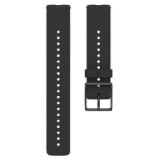Running Power
With Grit X/Grit X Pro/Grit X2 Pro/Pacer Pro/Vantage M3/Vantage V/Vantage V2/Vantage V3 running power from the wrist is calculated without any external sensors. With Pacer/Vantage M/Vantage M2 an external power sensor is required to measure running power.
What is running power?
Running power in the simplest sense is a mechanical work rate, measured in watts. Normally, we do mechanical work when we lift objects or climb stairs. In both cases, we do work against gravity. In running, we do work against gravity and friction as well. The faster we work the higher the power.
There is no universally accepted definition for running power. However, to validate our solution, we have used the following definition: Running power is a positive change in mechanical energy of the center of mass over one step cycle divided by step cycle time, where mechanical energy is the sum of kinetic and gravitational potential energy. By validation, we have not only confirmed that our power is accurate, but we have also ensured that repeated workouts produce consistent results (repeatability) and power responds rapidly to changes in intensity (responsiveness).
How is running power from the wrist calculated with Grit X/Grit X Pro/Grit X2 Pro/Pacer Pro/Vantage M3/Vantage V/Vantage V2/Vantage V3?
Polar running power from the wrist uses the information of speed and gradient obtained from GPS and barometric sensors. Final power is calibrated in a laboratory using force plates. Your weight also affects the calculation, so make sure its up-to-date.
The main difference compared to foot pod power sensors is that Polar Running Power from the wrist does not require any additional sensors.
Benefits of training with running power
Running power responds to increase in intensity almost instantaneously, has a high dynamic range, and takes into account changes in altitude. Thus it’s well-suited for interval training and running in hilly terrain.
Due to a high dynamic range, running power measures both aerobic and anaerobic power. This is useful in training as a runner can stay informed when maximal aerobic power (MAP) has been exceeded. Training at power that is greater than MAP (power zones 4 1�7 is essential in developing big and strong muscles capable of supplying a lot of work in a short period of time. Furthermore, running power helps to train progressively, yet safely, through a new parameter called Muscle Load.
Running power and muscle load
Polar uses running power to calculate Muscle Load, one parameter of Training Load Pro. Running causes musculoskeletal stress, and Muscle Load tells you how much your muscles and joints were strained during your training session. It shows the amount of mechanical work (kJ) that you produced during your running sessions (and cycling sessions if you’re using a cycling power meter). Muscle Load helps you quantify your training load in high-intensity running training sessions, such as short intervals, sprints and hill sessions, when your heart rate doesn’t have enough time to react to the changes in the intensity.
How running power is shown on your watch
Choose the power data you want to view during your sessions by customizing your training views in the Flow web service sport profile settings.
During your run you can view the following data:

- Maximum power
- Average power
- Lap power
- Maximum lap power
- Automatic lap power average
- Automatic lap power maximum
Choose how power is shown during sessions and in the Flow web service and app:
- Watts W
- Watts per kilogram W/kg
- Percentage of MAP (% of MAP)
After your session in the training summary on your watch you’ll see:


- Your average power as Watts
- Your maximum power as Watts
- Muscle Load
- Time spent in power zones
How running power is shown in the Polar web service and app
Detailed graphs for analysis are available in the Flow web service and app. See your power values from your session, and how they were distributed compared to heart rate, and how incline, decline and different speeds affected them.



































